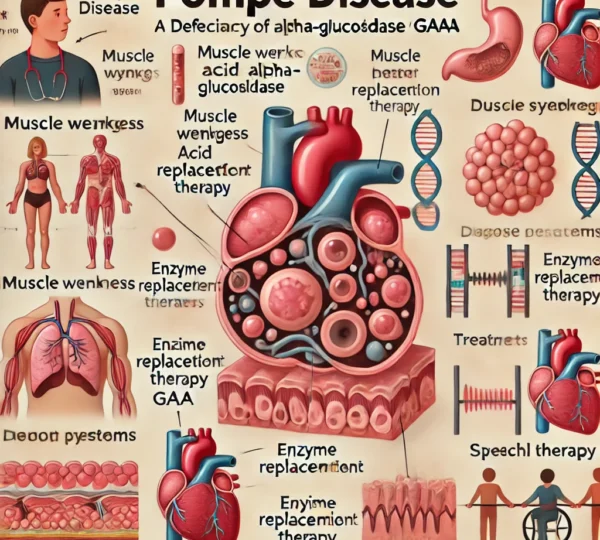Are You at Risk for Pompe Disease? Symptoms, Causes, and Treatment Options
Introduction: Understanding Pompe Disease
Pompe disease is a rare, inherited disorder affecting the muscles and organs. This condition occurs due to a deficiency of the acid alpha-glucosidase (GAA) enzyme, responsible for breaking down a sugar called glycogen. Without enough GAA, glycogen builds up in the muscles, causing progressive muscle weakness and other serious symptoms.
Understanding the symptoms, causes, diagnosis, and treatment options is crucial for those affected by Pompe disease.
What Are the Symptoms of Pompe Disease?
Symptoms of Pompe disease vary widely depending on the age of onset and severity. Common symptoms include:
- Muscle Weakness: This often begins in the legs and trunk, making daily activities challenging.
- Breathing Difficulties: Weak respiratory muscles may lead to shortness of breath and fatigue.
- Heart Problems: Infants, in particular, may experience an enlarged heart and other cardiac issues.
- Enlarged Liver: Liver enlargement, or hepatomegaly, is another common symptom in younger patients.
- Developmental Delays in Infants and Children: Delayed motor skills, such as crawling or walking, can occur due to muscle weakness.
For those with late-onset Pompe disease, symptoms may appear during childhood or adulthood and tend to progress more slowly.
Causes: The Genetics Behind Pompe Disease
Pompe disease is caused by a mutation in the GAA gene, which leads to a deficiency in the GAA enzyme. This enzyme helps break down glycogen, a stored form of sugar used for energy, particularly in muscles. Without sufficient GAA enzyme activity, glycogen accumulates in cells, particularly in muscle tissues, leading to muscle damage and the symptoms associated with Pompe disease.
Pompe disease is a genetic disorder inherited in an autosomal recessive manner, meaning both parents must carry the mutated gene for their child to be affected.
Diagnosing Pompe Disease: Key Tests and Examinations
Diagnosing Pompe disease often begins with recognizing symptoms, especially if there’s a family history of the disorder. Here’s what the diagnostic process typically involves:
- Medical and Family History: Your doctor may begin by reviewing your medical history and any family history of genetic disorders.
- Physical Examination: This may include an assessment of muscle strength, breathing ability, and organ size.
- Blood Tests: These tests can measure the level of GAA enzyme activity and glycogen levels in the blood.
- Genetic Testing: Confirmatory tests involve genetic testing to identify the mutation in the GAA gene, providing a clear diagnosis.
Early diagnosis is essential, especially for infants, as timely treatment can help manage symptoms and improve quality of life.
Treatment Options: Managing Pompe Disease
While there’s currently no cure for Pompe disease, treatment focuses on managing symptoms and improving the quality of life for those affected. Treatment options include:
- Enzyme Replacement Therapy (ERT): ERT involves administering the missing GAA enzyme through intravenous infusions. This treatment can slow disease progression, particularly in infants and children.
- Physical Therapy: Physical therapy helps improve muscle strength, mobility, and daily function. Exercises are customized based on individual needs, aiming to prevent muscle contractures and maintain flexibility.
online pharmacy buy tadalista with best prices today in the USA
- Respiratory Therapy: As respiratory muscles weaken, breathing support may be needed. This can include non-invasive ventilation devices to aid with nighttime breathing.
- Speech and Swallowing Therapy: Speech therapy can help improve speech and swallowing difficulties, common in individuals with weakened throat muscles.
These therapies, along with regular follow-ups with healthcare providers, can greatly improve daily life and reduce the impact of Pompe disease symptoms.
Living with Pompe Disease: Lifestyle Tips and Support
Living with Pompe disease can be challenging, but there are steps that can help manage symptoms and enhance well-being:
- Nutritional Support: A balanced diet, possibly with the guidance of a dietitian, may support energy levels and overall health.
- Emotional Support: Support groups and counseling can provide a network of individuals and families facing similar challenges.
- Regular Check-ups: Ongoing monitoring and assessments with healthcare providers ensure treatments remain effective and address any changes in symptoms.
With these measures, individuals with Pompe disease can lead fulfilling lives, adapting to their needs as symptoms change.
Conclusion: Taking Control of Pompe Disease
Pompe disease is a serious genetic condition, but it doesn’t have to be life-limiting. By understanding the symptoms, causes, diagnosis, and available treatment options, individuals with Pompe disease can make informed decisions and access the necessary support. If you suspect that you or your child may have Pompe disease, consult a healthcare professional for a proper diagnosis and guidance on the best treatment plan.



